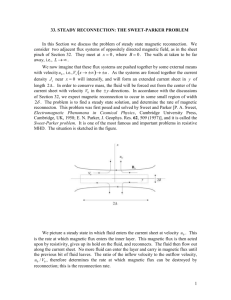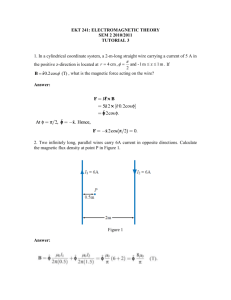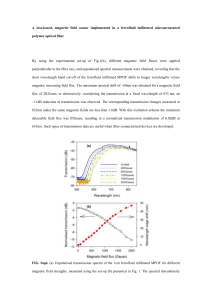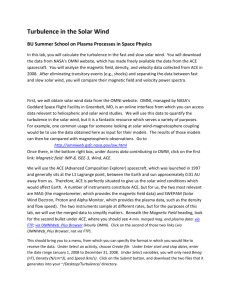Reconnection B
advertisement
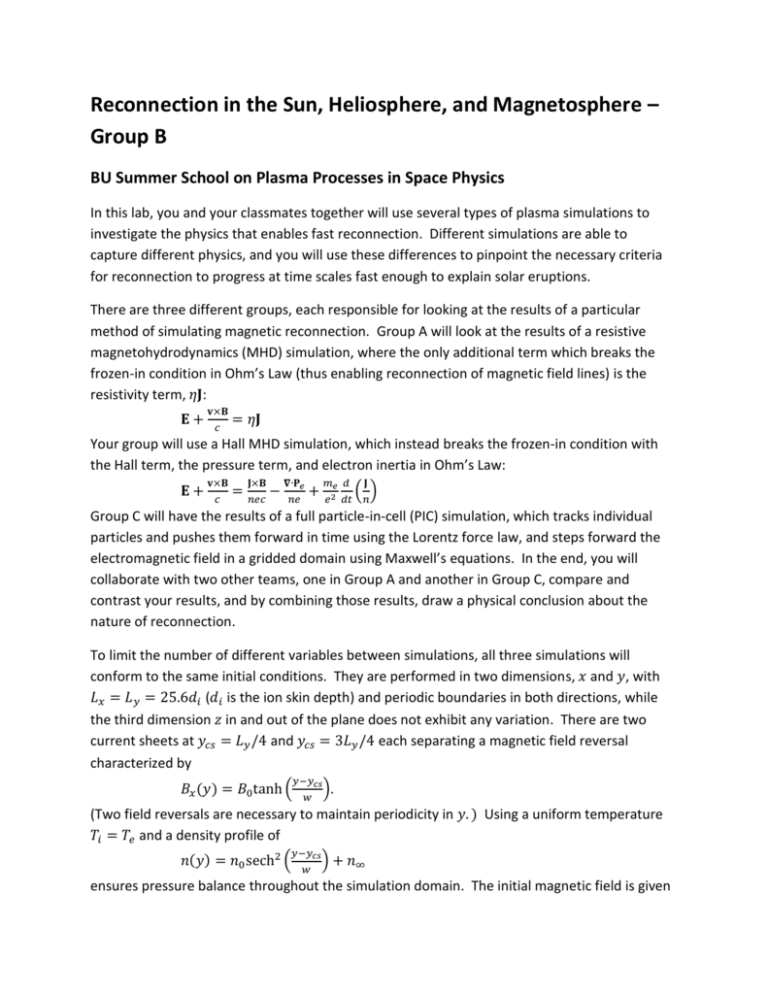
Reconnection in the Sun, Heliosphere, and Magnetosphere – Group B BU Summer School on Plasma Processes in Space Physics In this lab, you and your classmates together will use several types of plasma simulations to investigate the physics that enables fast reconnection. Different simulations are able to capture different physics, and you will use these differences to pinpoint the necessary criteria for reconnection to progress at time scales fast enough to explain solar eruptions. There are three different groups, each responsible for looking at the results of a particular method of simulating magnetic reconnection. Group A will look at the results of a resistive magnetohydrodynamics (MHD) simulation, where the only additional term which breaks the frozen-in condition in Ohm’s Law (thus enabling reconnection of magnetic field lines) is the resistivity term, 𝜂𝐉: 𝐄+ 𝐯×𝐁 𝑐 = 𝜂𝐉 Your group will use a Hall MHD simulation, which instead breaks the frozen-in condition with the Hall term, the pressure term, and electron inertia in Ohm’s Law: 𝐄+ 𝐯×𝐁 𝑐 𝐉×𝐁 = 𝑛𝑒𝑐 − 𝛁∙𝐏𝑒 𝑛𝑒 𝑚𝑒 𝑑 + 𝐉 ( ) 𝑒 2 𝑑𝑡 𝑛 Group C will have the results of a full particle-in-cell (PIC) simulation, which tracks individual particles and pushes them forward in time using the Lorentz force law, and steps forward the electromagnetic field in a gridded domain using Maxwell’s equations. In the end, you will collaborate with two other teams, one in Group A and another in Group C, compare and contrast your results, and by combining those results, draw a physical conclusion about the nature of reconnection. To limit the number of different variables between simulations, all three simulations will conform to the same initial conditions. They are performed in two dimensions, 𝑥 and 𝑦, with 𝐿𝑥 = 𝐿𝑦 = 25.6𝑑𝑖 (𝑑𝑖 is the ion skin depth) and periodic boundaries in both directions, while the third dimension 𝑧 in and out of the plane does not exhibit any variation. There are two current sheets at 𝑦𝑐𝑠 = 𝐿𝑦 /4 and 𝑦𝑐𝑠 = 3𝐿𝑦 /4 each separating a magnetic field reversal characterized by 𝑦−𝑦𝑐𝑠 𝐵𝑥 (𝑦) = 𝐵0 tanh ( 𝑤 ). (Two field reversals are necessary to maintain periodicity in 𝑦. ) Using a uniform temperature 𝑇𝑖 = 𝑇𝑒 and a density profile of 𝑦−𝑦𝑐𝑠 𝑛(𝑦) = 𝑛0 sech2 ( 𝑤 ) + 𝑛∞ ensures pressure balance throughout the simulation domain. The initial magnetic field is given a sizeable perturbation to the flux function 2𝜋𝑥 2𝜋𝑦 𝜓(𝑥, 𝑦) = 𝜓̃cos ( 𝐿 ) cos ( 𝐿 ) 𝑥 𝑦 to accelerate the reconnection process so that it begins in the nonlinear regime, and to place a single initial x-line on each current sheet at a specified location, namely (𝑥, 𝑦) = ±(6.4, −6.4), to go with a magnetic island at (𝑥, 𝑦) = ±(6.4,6.4). Length units are normalized to the ion skin depth 𝑑𝑖 = 𝑐/𝜔𝑝𝑖 = √𝑚𝑖 𝑐 2 /4𝜋𝑛0 𝑒 2 , time to the ion cyclotron period Ω−1 𝑐𝑖 = 𝑚𝑖 𝑐/𝑒𝐵0 , velocities to the Alfvén speed 𝑐𝐴 = 𝐵/√4𝜋𝑛0 𝑚𝑖 , magnetic fields to the asymptotic reversed field 𝐵0, and densities to the current sheet density 𝑛0 . The relevant parameters are 𝑤 = 0.5𝑑𝑖 , 𝑛∞ = 0.5𝑛0 , 𝑚𝑖 /𝑚𝑒 = 25, and 𝐵̃ = 4𝜋𝜓̃/𝐿𝑥 = 0.1. (Most of these details are simply that: details. The important thing is that all three simulations have the same details, because if they turn out differently, we want to understand from where those differences arise.) The simulation has already been performed for you. First, open a terminal by clicking on the penguin on the bottom left, then in Accessories, Terminal. From that terminal, change your directory to the proper directory: cd ~/Desktop/Reconnection/GroupB then start IDL by simply typing idl. To load the data from the simulation, type IDL> .run hallMHDsim Below is a list of some of the variables which should have loaded: Variable Dimensions Description bx, by, bz 512 × 512 × 32 magnetic field jz 512 × 512 × 32 z-component of current density xx, yy 512 x- and y-coordinates for each grid point tt 32 t for each time slice dx, dy 1 grid spacing = 0.05𝑑𝑖 dt 1 time step = 0.5Ω−1 𝑐𝑖 lx, ly 1 system size= 25.6𝑑𝑖 The variables bx, by, bz, and jz are 512 × 512 × 32 arrays, corresponding to 32 time-slices of two-dimensional data for the magnetic field and the out-of-plane current density. The first array index corresponds to its location in 𝑥, the second to 𝑦, and the third to the time 𝑡. Note that IDL indices go from 0 to N-1, where N is the size of that dimension. For example, you could plot the initial current density along a vertical cut at the leftmost boundary 𝑥 = −𝐿𝑥 /2 with IDL> plot, yy, jz[0,*,0] As another example, to see the initial out-of-plane current density over the whole domain, type IDL> image, jz[*,*,0], xx, yy You should see two current sheets at 𝑦 = ±6.4, in accordance with the initial conditions described above. Look at jz for various time-slices to get a feel for the evolution of the system. 1. What happens to the reconnected flux? Where does it pile up? 2. Describe the structure of the current sheet. Is it long and narrow, or does the nozzle widen into the magnetic island? Now we will look for the Hall quadrupolar signature described by Prof. Drake in today’s lecture. Consider the figure below, which shows a pair of magnetic field lines immediately following reconnection. Imagine that the newly reconnected magnetic fields below are pulled out of the page, in such a way that the parts nearest to the x-line in the center are pulled up. You could think of them as strings laying on the table which you pick up by their respective centers. 3. Label the direction (into the page or out of the page) of the out-of-plane magnetic field. Within each circle, draw either ⨂ or ⨀ corresponding to the direction of the Hall quadrupole signature. 4. In your simulation, do you see anything develop in bz over time? In particular, do you see this quadrupolar structure develop in the vicinity of the x-lines? Why or why not? Now, we will attempt quantify the amount of reconnected flux as a function of time. To this end, we define the flux function 𝜓 of the in-plane magnetic field, such that 𝐁(𝑥, 𝑦) = 𝐳̂ × 𝛁𝜓(𝑥, 𝑦) + 𝐵𝑧 𝐳̂. 5. Using this definition, how would you write a basic IDL program to calculate 𝝍 from 𝑩𝒙 and 𝑩𝒚 for a given time slice(s)? You may write pseudo-code (or actual IDL code) below, or simply describe the procedure in words. Hint: Your procedure will require not only bx and by as inputs, but also the gridspacing dx and dy. (Why?) You may also take 𝝍 = 𝟎 at the bottom-left corner of the simulation domain, i.e., psi[0,0,t] = 0. (Why?) For now, just use the ready-made procedure fluxfunc to calculate psi: IDL> psi = fluxfunc(bx,by,dx,dy) You can use the newly calculated flux function to visualize the in-plane magnetic field, because contours of 𝜓 correspond to magnetic field lines. Therefore, to see the initial in-plane magnetic field, enter IDL> contour, psi[*,*,0], xx, yy, nlevels=20 Observe the flux function along the current sheet progress in time for t = 0 to t = 31: IDL> plot, xx, psi[*,127,t] 6. Locate in x where the maximum and minimum of 𝝍 along these cuts occur. Do these locations correspond to any places of interest in the simulation? Write down the value of 𝝍 at these locations at several different times. How can you obtain from this information the amount of reconnected flux at a given time t? 7. Use 𝝍 to calculate the amount of reconnected flux and its time-derivative, the reconnection rate. Plot both as a function of time and print. Based on the latter plot, write down a typical value for the normalized reconnection rate at late times. (Because the plot was taken from a derivative, it may be quite jumpy. That is not unexpected. Simply estimate an average value.) Find two other groups, one which performed this analysis on the resistive MHD simulation, and another which looked at the PIC simulation. Compare and contrast your results with both of the other groups. 8. How did your answers to Questions 1-7, and in particular the plots you generated for Question 7, compare with those of the other groups? Which two simulations were most similar to one another? 9. Lastly, make a single plot which shows the reconnected flux as a function of time for all three simulations. Print out this plot. What trends do you see among the three simulations? What conclusions can you draw regarding the relationship between Hall physics, the structure of the outflow region, and fast reconnection?

